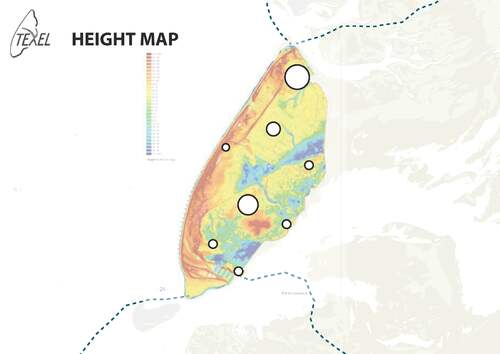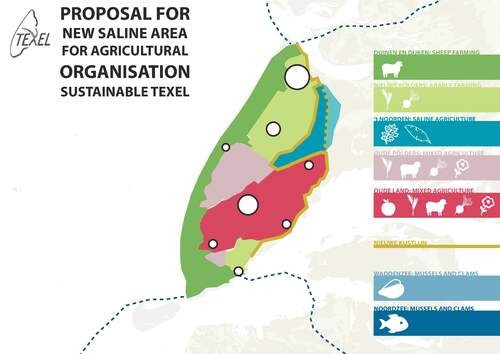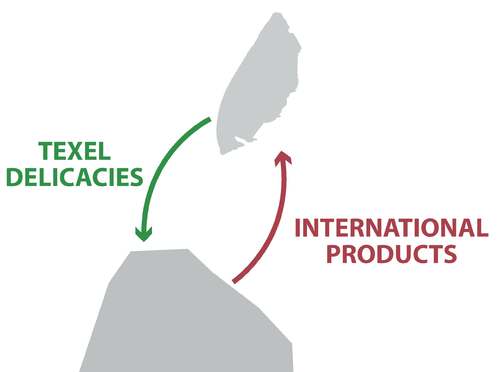The subsystem ‘Food and More’ encompasses everything to do with types of food, the distribution of this food and the effects these actions have on the ecosystem.
4.1 Present scenario
Presently, Texel earns its maximum revenue from the food sector with a turnover of about 30 million Euros. This is due to the fact that there has been considerable field enlargement and land consolidation since the 1960s. The island has around 220 farms focusing on dairy, vegetables, sheep and a mix of all of these. Having such a diverse classification has caused the people to form a local marketing association where they help each other by selling their wares together.

Fig 4.1: Farm Statistics in Texel
There are sanctions on irrigation because of the lack of fresh water sources on the island. The only way to obtain this fresh water is by transporting it from the mainland, which in large quantities can be very expensive. This also stresses on the need to have various research groups work on saline agriculture.

Fig 4.2: Maps of Texel
Shown above in Fig 3.2 is the basic height map of Texel, 'Red' is high and 'Blue' is low. This gives a clearer picture with regards to which areas can be modified as locations for farmlands, grasslands and preserved area. The lower areas are covered with saline soil. In these areas traditional agriculture is impossible. Saline soil is a major problem worldwide.
One of the sectors that are already shifting to more locally produced food are the restaurants. Restaurants in Texel are having locally produced food on the menu with sheep as a speciality. Jef Schuur a Michelin star chef has set up his restaurant in Den Hoorn which serves the Texel sheep. These unique sheep have a salty taste and a smooth texture due to the grass that they feed on and the salty air that they breathe. There are also locally brewed beers and herbal liquors available. The local people in Texel don't eat that much locally produced food. Most products in supermarkets are imported from the mainland. However, with up and coming entrepreneurs this mentality is changing.
Texel’s migratory birds are important to the ecosystem and there is an environmental co-operative for Texel called the De Lieuw which contracts farm land. For each hectare contracted the farmer owning the farm land must participate in nest count and surveys. The farmers presently receive subsidies from the government. Of this subsidy, they pass on some of the money to the co-ops - organisations that are in charge of looking after the wildlife and the ecosystem.
4.2 Future scenario
Taking the ideal scenario where Texel is self – sustained (in terms of food) the population of Texel depends on the available arable land which depends on the available land that can be made arable (converted to farm land). However, to make a conservative estimate it has been decided that Texel should provide for more than 30% of its food needs as well be able to export 30% of its sheep.
There will be two ways to improve produce in Texel. First will be for Texel to grow in size - it must be able to reclaim land from the sea without harming the ecosystem nearby. Another way will be to improve the present farming methods; organic farming is something that can be done easily and is known to improve the output by almost 15% over the time period of 5-10 years. Mechanised farming is out of the question because this gives most efficient output for large land holdings, and land size is a major concern in Texel.

Fig 4.3: Agricultural map of Texel
To make the argiculture more profitable the land should be divided in areas with different kinds of argicutlure. Every area has its own character and its own use. Fig 3.3 shows our proposal for the future argicultural division of the island. As shown in Fig 3.3, the location to the north east of the island shown in ‘dark blue’ can have a controllable dyke shown as a ‘yellow dotted line’. This is the location where saline agriculture can be practised and research groups can work on their research. The dyke defines how much water is needed, on the other side of the dyke is the Wadden Sea shown in ‘light blue’ and here is where the clams and mussels are fished. The white dots shown in the map are the cities and towns. The most fertile land is shown in ‘red’ and here is where mixed agriculture can be practised. The green patch running from the North West to the South West of the island is where the sheep can be reared and is called the dunes. Since Texel is a home to many unique bird species and its island ecosystem is critical for its survival there is a minimum limit of 4000 hectares to be empty grasslands so birds can use them as nesting grounds.

Fig 4.4: Texel Food Swap
Besides the division of the land there should also be a transition from bulk products to more high-end products, like delicacies, in order to make the agricultural sector more profitable. These high-end products are worth more and will be attractive to tourists. These products can also be exported to the mainland. There can be a special market which sells Texel’s exotic goods on the mainland. This includes, the saline potatoes, Texel sheep, cheese, mussels, clams and beer. The ferry which transports these goods to the mainland can also bring back food from the mainland to Texel – a possible ‘food swap’ as shown in Fig 3.4. This idea will reduce the transportation costs tremendously and also prevent the Texel farmers from competing with the farmers from the mainland. This sort of marketing will get the people from the mainland interested to purchase these exotic Texel goods and Texel will benefit from this.
There will be more restaurants like Jef Schuur’s which offer local food at affordable prices. Everyone will eat locally and hence the import costs will reduce tremendously. Sheep’s milk and cheese will replace cow’s milk as it will become a staple diet for the people of Texel. There will a large change in the mind-set of the people and new entrepreneurs will come up with sustainable ideas to produce food locally and ideas like hosting an annual Texel fair – where competitions will showcase people and their products. The best will be crowned the winner and their methods to improve the products will be implemented. Also supermarkets should sell more locally produced food. In this way also local people will eat more local produced food. It is import however that the prices are kept low, otherwise local people won't changes their habits.
The government should provide the farmers with subsidies as well as financial protection in case of a calamity or disease to mitigate losses incurred by the farmer. The government may either tackle this by itself or by sub - contracting this to insurance companies which can help with the policy making. Another way to mitigate losses can be that farmers and the other Texelaars would have a farmers union where different people can invest and the profits can be distributed evenly. As mentioned previously the Texel farmers do not have a good reputation among the Texelaars. This sort of union can create a harmonious bond between the two groups and hence improve the reputation of farmers among other Texelaars.
All the sub – systems of Texel will work in harmony with each other. The waste from Food and More Sub - System (SS) will be handled by the Materials and Waste SS. The food from the Food and More SS will be marketed throughout Texel and the mainland by the Health and Happiness SS. The research on saline agriculture will help the Leisure and Knowledge SS. These are barely a fraction of the numerous interactions that await Texel in the future and all of these SS will work synchronise and work to create a self - sustaining Texel. This will ensure that island does not need to depend on the mainland for majority of its support and will be able to fend for itself. More about the integration with other subsystems can be found in Chapter 6.
References
[2] http://www.globalislands.net/greenislands/index.php?region=8&c=27

